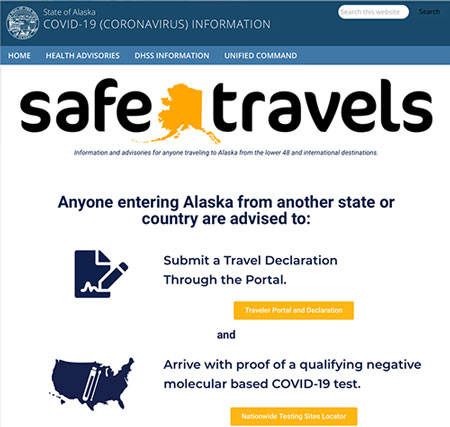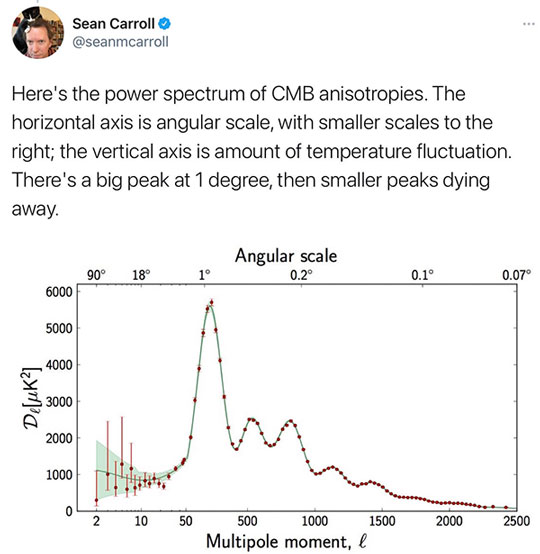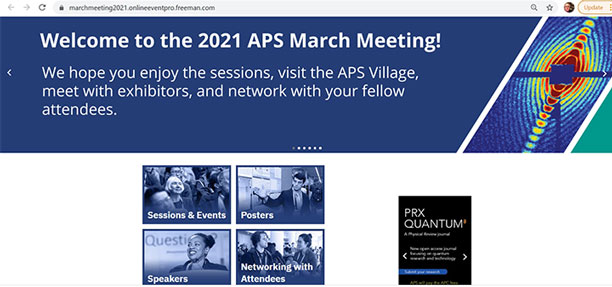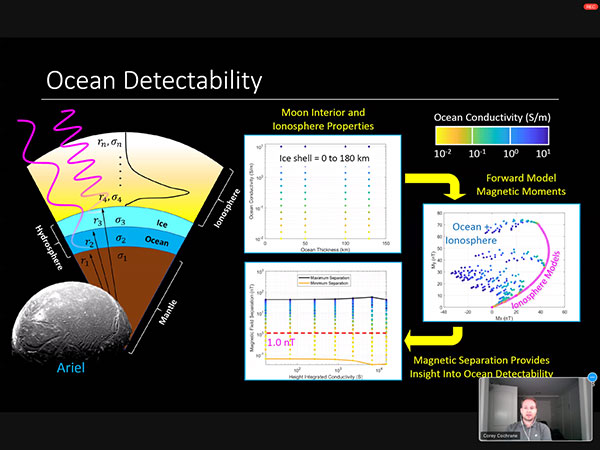Greetings from Palmia Observatory
Well this week is going to be busy with online virtual conferences sponsored by the American Physical Society (APS), who is conducting their March Meeting which concentrates on condensed matter physics. Also the Lunar and Planetary Society (LPSC) is holding their online 52nd annual conference meeting. But, before it all gets started, we have other activities to report on including the attempt to see if the March 16 predicted string of lights from Starlinks satellites would be visible.
Sadly, no, we could not see any satellites in the cold early morning. Check out this one of image of dozens taken starting at 6:04 am, March 16. The camera was positioned looking toward north and about 15 degrees above the horizon. No satellites showed up in any of the images. The prediction was for dim viewing at magnitude = 4.4 and it also seemed there were light thin clouds, which might have interfered. Usually, I can see Polaris, magnitude 2, but this morning I couldn't make it out either.
 |
| Didn't see any Starlinks at 6:04 am PT, 30mm, ISO3200, 1/3 second (Source: Palmia Observatory) |
While waiting for the parade of satellite lights, my smartphone reminded me of where we where two years ago in March 2019. We were in Fairbanks Alaska looking for the Northern Lights, of which we saw none because of those darned clouds. At least we had a good time, part of which was enjoying this dog sled ride outside of Fairbanks. The temperature then was a bit colder then at between 19 - 43 degrees F, but the current temperature forecast for Fairbanks is between a high of say 18 and a low of -3 degree F. Brrr!
 |
| Resident Astronomers enjoy dog sled ride in Fairbanks, but no lights (Source: Palmia Observatory) |
But March is supposed to be a pretty good month to observe the northern lights, so what are the restrictions to travel back to Alaska during the pandemic. The state website does not mention anything about those who have been inoculated, but be prepared to do some paper work and complete a negative COVID-19 test. Other online comments said that those who are inoculated still need to provide a recent negative test result, but do not have to strictly quarantine until the test results are available. So, hopefully, we can shortly plan for another visit to Fairbanks in search of the northern lights.
 |
| Travel restrictions to Alaska currently require a plan and test (Source: covid19.alaska.gov) |
Before getting back to more astronomy and physics topics, it is hard to go forward without doing a little catching up homework on viruses. This YouTube video from Ninja Nerd Lectures, Zach Murphy, PA, offers a pretty good introduction to the various variants of the Coronavirus. There are bigger issues about degree of infectiousness and effectiveness of the current batch of vaccines, but for now we need to just come up to speed on what it means to be a viral variant. This video is easier to follow than than the more technical lectures by Professor Vincent Racianello, Columbia U, even though it does not go much into the variant nomenclature that I was hoping for. Nonetheless, check it out at: https://www.youtube.com/watch?v=OYgVmOLF2mY
 |
| Introduction to SARS-CoV-2 viral variants (Source: Ninja Nerd Lectures) |
Ok, after all of these other topics, let's get back to some astrophysics. Sean Carroll, Caltech, tweeted a reminder to us all regarding the nature of the evidence supporting the dark matter hypothesis. In astrophysics, we begin with Zwicky's study of clusters and how applying the virial equation and how the observations of visible matter did not seem to be enough for clusters to be stable and that they should just fly apart. Well this missing dark matter was also found to be a good explanation for the observed flat orbital velocity curves found for stars in galaxies.
Sean shows the predicted CMB power spectrum for the standard cosmological model with about 5 times more dark matter compared to normal matter. Note how the 2nd and 3rd peak are roughly the same size. This is a prediction of a dark matter universe.
 |
| Power spectrum of observed CMB (Source: @seanmcarroll) |
Next Sean reminds us that when alternate theories of gravity are used to explain the orbital velocities of stars in galaxies, without using dark matter, cannot explain the observed power spectrum in the 2nd and 3rd peaks. Modified gravity models predict a decreasing amplitude in the various peaks, but this is not observed and does not fit the observed CMD anisotropies.
 |
| Dark matter model fits the observed data better than modified gravity models (Source: @seanmcarroll) |
This dark matter model and use of the scientific method to get closer to a better understanding of our universe brings to mind a recent video discussion on epistemology and how we come to know anything in our modern world. We have just gone over how the scientific method is used successfully to disentangle the CMB measurements and orbital speeds to find the best fit with the observed data. This discussion with Daniel Schmachtenberger is also pretty enlightening. He begins with the epistemological issue of how we make sense of the world at all, but how the whole problem is compounded in our modern age when the sources of information are provided for us by various actors, whose intentions in providing the information are not entirely clear and their motives might not coincide with our best interests. Just consider our previous posts about the nature of information provided to us by Google and Facebook and other sources and how the algorithms that supply the like and recommendations to us is not known by us. Yes, it is nice to get recommendations about a topic that we are interested in, but to get at the truth or reality of the situation we need to get the opposing viewpoints as well.
If you want more discussion of our modern epistemological situation then check out this almost two hour YouTube video at: https://www.youtube.com/watch?v=7LqaotiGWjQ
 |
| The War on Sensemaking (Source: Daniel Schmachtenberger) |
Finally, we can return for some introductory comments about the APS March meeting and the LPSC meeting. Normally, I am just an APS April meeting type of physicist wannabe, but with the March meeting being online, it was easy to just try it out too and have a look around. Remember that the March meeting is primarily concerned with condensed matter and various forms of atomic physics. I haven't had a lot of luck finding any sessions that I could begin to understand, but look forward to discussions on the foundations of quantum mechanics, which comes up later in the week.
 |
| APS March Meeting, online from March 15-19, 2021 (Source: www.march.aps.org) |
But, in scanning the list of topics and sessions I saw the topic "Quantum Annealing" and how it was being used in some types of quantum computers to solve very intractable optimization problems. Hmm, so what is quantum annealing?
A quick search of YouTube finds many videos and discussions on the topic. I can comment on some of my findings here. Quantum annealing is based on simulated annealing that is used to solve optimization problems. Consider the following example where it is desired to minimize or maximize some function. We could use some Monte Carlo approach to randomly move over the available phase space and examine each point and search for the maxima, but for some large classes of problems this approach takes way too much time.
 |
| Using quantum annealing to achieve big increase in generating optimal solutions (Source: CTI) |
The name comes from the classical understanding of annealing as used in metallurgy. There annealing is used to change the physical characteristics of the metal by first raising its temperature. Then as the metal cools, the order and structure of the metal changes in a way that minimizes the energy levels that result. This improves the ductility of the metal and this result occurs naturally and somehow the nature of quantum mechanics just causes the minimization to occur.
 |
| Quantum annealing is based on how classical annealing results in lowest energy state (Source: CTI) |
So in quantum computing the approach is to program the optimization problem in something like a Lagrangian and then all the quantum computing network just solve the optimization problem. Quantum annealing can use quantum tunneling to very quickly find the minimum or maximum that is desired. This is what enables the very large increase in speeding up the calculation, much more than is possible with classical computing. So, that is pretty neat, eve though I really still don't have a good understanding of how that is done!
 |
| Quantum computers offer huge speedup in solving optimization problems (Source: CTI) |
If you want more of the details on this approach and explanation of quantum annealing, check out the short 26 minute CTI video at: https://www.youtube.com/watch?v=NwoD82hDImM
Now, as if trying to scan the online March meeting was not enough, the LPSC 52nd meeting is also being held at the same time. You can see that you can click on the auditorium for lectures or the exhibit hall to visit the sponsors and equipment manufacturers. I haven't clicked on the "Lounge" yet, but I doubt if I could get a martini there like I could when the conferences were live!
 |
| Virtual Lunar and Planetary Science Conference, March 15-19, 2021 (Source: www.hou.usra.edu) |
I will mention just one slide that I found interesting and that was how ocean detectability of moons can be detected and investigated remotely. Many moons in our solar system orbit around their host planet and the planet has a magnetic field that passes through the moon. The motion of the moon induces currents in the moon that can be detected and depending on the conductivity of the moon it is possible to get an idea of what the subsurface looks like. The ice, water and mantle all have different conductivities so the generated EMF contains information about the nature of the internal structure.
I find that I am getting pretty much "zoomed out" and not eager to follow a lot more of zoom meetings, but I'll try to make other comments about the other sessions later.
 |
| Ocean detectability on moons (Source: Corey Cochran, LPSC 52, 2021) |
Until next time, here from our burrow, stay safe, as we recover more of our freedom,

No comments:
Post a Comment